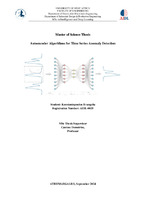Autoencoder algorithms for time series anomaly detection
Αλγόριθμοι autoencoder για ανίχνευση ανωμαλιών σε χρονοσειρές

Μεταπτυχιακή διπλωματική εργασία
Συγγραφέας
Κωνσταντοπούλου, Ευαγγελία
Ημερομηνία
2024-09-02Επιβλέπων
Κάντζος, ΔημήτριοςΛέξεις-κλειδιά
Time series ; Anomaly detection ; Autoencoders ; Semi-supervised learning ; Χρονικές σειρές ; Ανίχνευση ανωμαλιών ; Αυτόματοι κωδικοποιητές ; Ημι-εποπτευόμενη μάθησηΠερίληψη
Time series data capture the behavior of variables over time and as such they are of core importance in a broad variety of scientific disciplines and applications including finance, industry, healthcare and networks, among others. In many use cases, it is crucial to ensure that the observed variable behavior corresponds to a historical normality. When deviations from the norm occur, it might signify a problem or an event of interest, so detecting them is important in order to take appropriate actions. In this thesis the problem of time series anomaly detection is tackled from a data-driven approach, focusing on the use of Autoencoders. Methodologically, the problem is addressed using semi-supervised learning, where all models are trained solely on normal data. The underlying assumption is that a model trained to capture only normal data behavior will underperform when fed with data anomalies. Several Autoencoders are developed and compared to other commonly used anomaly detection methods to assess their ability. Different constraints were are applied to each Autoencoder to evaluate how addressing their tendency to overfit training data towards the identity mapping, can influence their performance. Additionally, a custom Autoencoder-based scheme, named “Fusion Autoencoder”, is designed and implemented to account for past input data, i.e., possible memory effects. During the detection stage, a sliding window is employed which enables to smooth model outputs and produce confidence intervals for models that do not natively support it. All the models are evaluated using the UCR Anomaly Archive, a carefully constructed dataset free from common dataset flaws, ensuring reliable results. Model performance is evaluated using three different categories of metrics to provide an exhaustive assessment over multiple different aspects of their performance. To bring out the strengths and limitations of each model, the conducted experiments focus on two main axes: overall performance comparison between the different models and performance on different types of anomalies. Although all of the implemented autoencoders performed better than the other models, the simplest one, the “Vanilla” autoencoder, outperforms the rest by a significant margin.
Αριθμός σελίδων
89Σχολή
Σχολή ΜηχανικώνΑκαδημαϊκό Τμήμα
Τμήμα Ηλεκτρολόγων και Ηλεκτρονικών ΜηχανικώνΤμήμα Μηχανικών Βιομηχανικής Σχεδίασης και Παραγωγής

